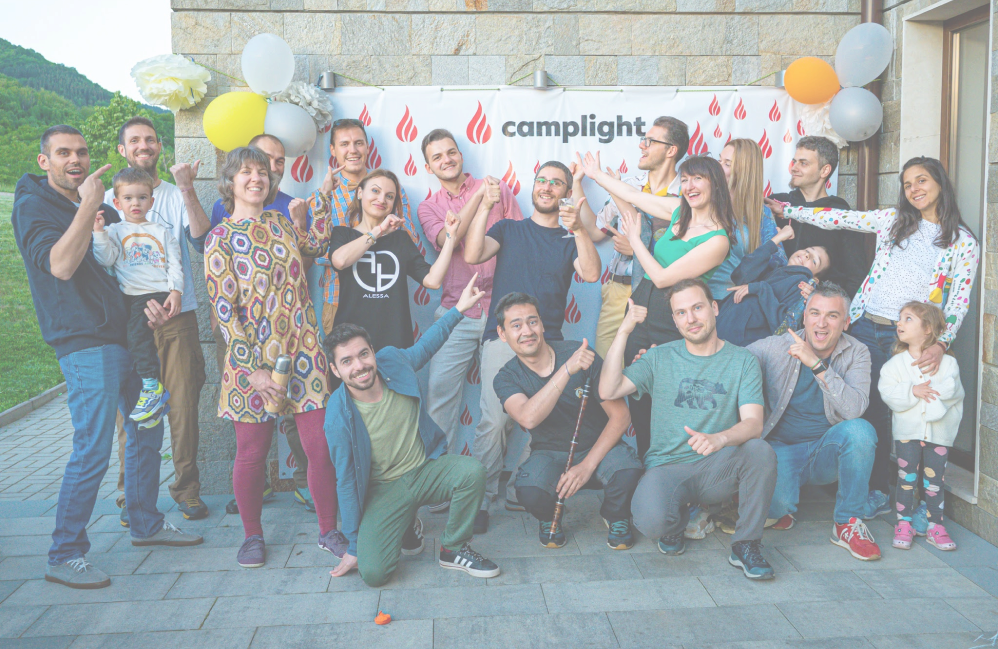Every time we mention that Camplight is a cooperative with 20+ co-owners, we get the same reaction: “Wow, how do you guys make decisions? It must be very slow and ineffective.”
This assumption isn’t surprising. The image most people have of cooperatives involves endless meetings, decision paralysis, and the frustrating pursuit of perfect consensus where everyone must agree before anything can move forward.
Our reality couldn’t be more different. We’ve developed a decision-making framework that’s always more efficient than traditional hierarchical organizations, one that balances meaningful, inclusive participation with the speed modern businesses require.
Modern decision-making increasingly relies on data-driven insights to maintain this balance of speed and inclusion. Learn how AI can accelerate your team’s decision-making process by turning complex data into actionable strategies that support both rapid execution and meaningful participation.
The rollercoaster to find this balance wasn’t straightforward. It required experimentation, failure, and a willingness to challenge our own assumptions about how decisions should be made. Formalizing our decision-making process and developing structured methods became essential as Camplight experienced strong growth in recent years, requiring us to efficiently onboard new team members while maintaining and improving our operational effectiveness through inclusive practices that keep everyone engaged without slowing us down.
The Catalyst for Change
This transformation didn’t happen by accident. It began when Marin Petrov, one of our co-owners, together with other Camplighters, recognized that our decision-making processes weren’t scaling with our growth. Drawing on his background in facilitation and team dynamics, Marin became the initiative driver for reimagining how we make decisions at Camplight.
“I noticed we were spending more time in meetings but making fewer clear decisions,” Marin explains. “We had good intentions about inclusion, but we lacked structure. The result was frustration on all sides – people felt both overwhelmed by meetings and somehow still left out of important decisions.”
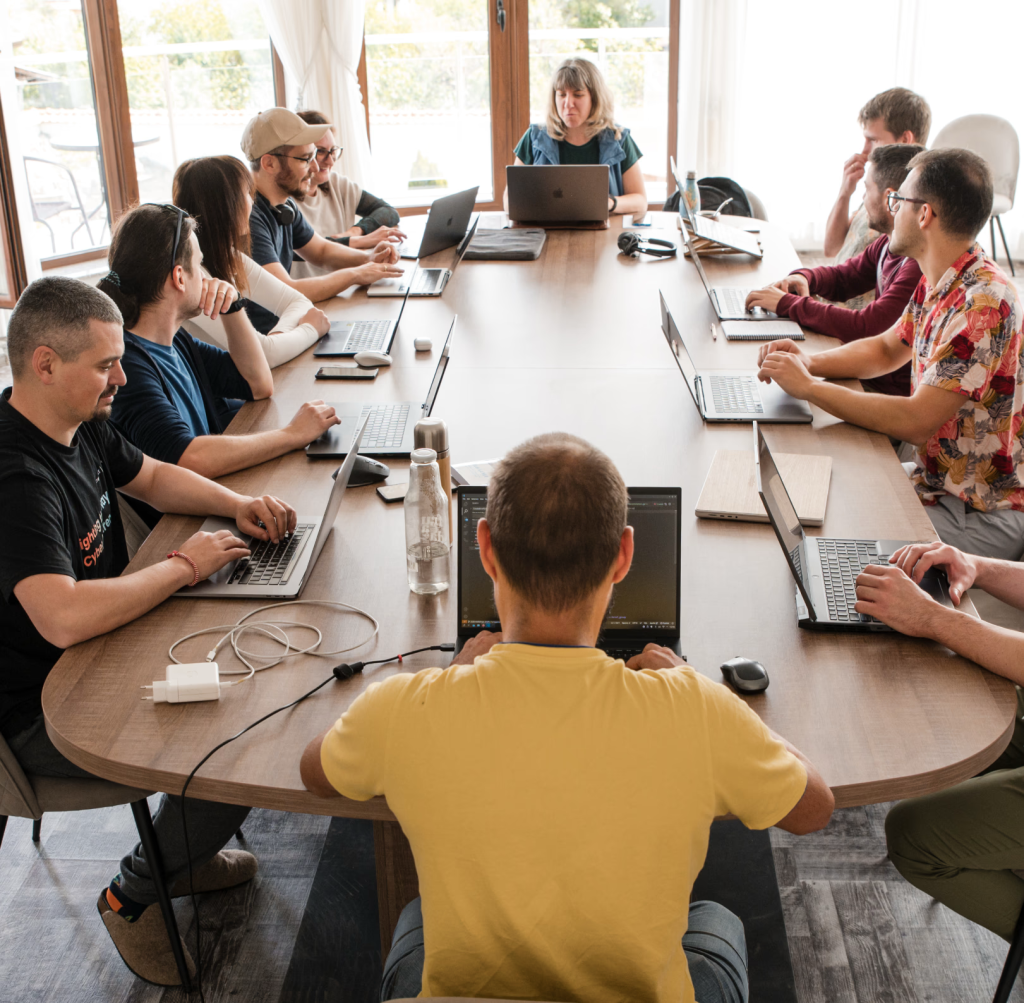
What started as an internal improvement initiative evolved into a comprehensive framework that now shapes not only how we work together but also how we deliver value to our clients.
Beyond Internal Practice: A Business Advantage
At Camplight, our decision-making framework isn’t just an internal practice. It’s fundamentally connected to how we deliver value to our clients. As a strategic tech partner for established, non-technical businesses, we’ve discovered that the same challenges that influence internal team decisions also compromise product and venture development.
The methods we’ve refined for our cooperative governance have become a competitive advantage in how we help clients avoid building the wrong thing, accelerate innovation, and maintain clarity while navigating the chaos of digital transformation.
The Decision-Making Crisis Across Organization Types
Traditional Hierarchies or The Illusion of Efficiency
The conventional wisdom suggests that top-down decisions are faster and clearer. One person (usually at the top) makes the call, and everyone else executes. Simple, right?
The reality we’ve observed is quite different. In hierarchical organizations, information must travel up and down the chain of command, creating bottlenecks and distortion. When decisions are made without incorporating the perspectives of those who will implement them, we see resistance, workarounds, and the infamous “meeting after the meeting” where real concerns are voiced only after the decision-maker has left the room.
We witnessed this firsthand with a client whose traditional structure was actually slowing down critical product decisions. Information about user needs wasn’t reaching decision-makers, while implementation teams felt no ownership of choices made without their input. The result? Lengthy delays and features that missed the mark.
Consensus-Based Organizations or The Inclusion Trap
On the other end of the spectrum, many well-intentioned organizations (including Camplight in our early days) fall into the consensus trap. The thinking goes: “If we include everyone in every decision, we’ll make better choices that everyone supports.”
While inclusive in theory, this approach often leads to decision paralysis or watered-down compromises that represent the lowest common denominator rather than the best solution. We experienced this firsthand in our early days, when reaching consensus on everything from technical architecture to office supplies consumed enormous energy and time.
In one particularly painful example, a simple decision about our project management tool stretched across three meetings and countless Slack threads over six weeks. Despite all that discussion, the final choice satisfied no one completely and left team members exhausted by the process.
The False Dichotomy
The breakthrough came when we realized we were trapped in a false dichotomy. Decision-making doesn’t have to be either autocratic or consensus-based. Different decisions call for different approaches.
Some decisions benefit from broad input, while others need clear ownership. Some require deep alignment, while others simply need to be made quickly. The key is matching the right method to each situation, a practice that transformed our effectiveness both internally and with clients.
The Trust Foundation
Unlike traditional organizations built on the premise that people need supervision, our decision framework operates on trust. We fundamentally believe that people naturally want to perform good work and can be trusted to act in the organization’s best interest.
This trust foundation makes our decision methods more than just processes, they’re expressions of our fundamental values and beliefs about human potential. When people know they’re trusted, they bring their best thinking to decisions and take ownership of outcomes in a way that command-and-control structures rarely achieve.
The Camplight Approach: Initiative-Driven Decision Making
Our Initiative Structure
Rather than organizing around departments or rigid hierarchies, Camplight structures work around initiatives, focused efforts with clear purposes and timeframes. Each initiative has a “driver” who takes responsibility for moving it forward, including making or facilitating appropriate decisions.
This differs fundamentally from traditional project managers or team leads. Initiative drivers don’t derive authority from a position in a hierarchy but from their commitment to serving a specific purpose. They’re accountable for results but empowered to determine how best to achieve them, including which decision methods to use in different contexts.
This approach has received recognition beyond our walls. Camplight was recently nominated among 50 self-managed organizations for the ZeroDX award by Corporate Rebels, highlighting our innovative approach to organization and decision-making.
The Decision Map Concept
The most transformative insight in our journey was realizing that not every decision deserves the same process. Some decisions warrant deep participation, while others need clear ownership and swift resolution.
We developed what we call a “Decision Map”, a shared understanding of which types of decisions use which methods. This simple tool creates clarity about expectations and appropriate involvement, eliminating the confusion and frustration that often surround decision processes.
By explicitly choosing the right method for each decision type, we’ve dramatically improved both the quality of our decisions and the efficiency with which we make them.
Note: Our comprehensive Decision Map framework and templates are available exclusively in the Decision Making Masterclass
Five Decision Methods in Our Toolkit
1. Consent Process
The Consent Process represents a powerful middle path between autocratic decisions and full consensus. Unlike consensus, which asks “Do you agree this is the best decision?”, consent asks a different question: “Can you live with this decision?”
This subtle but profound shift transforms decision dynamics. The standard isn’t perfect agreement but “safe enough to try” and the absence of valid objections that would cause harm.
We use the Consent Process for team-wide decisions that affect our shared work processes. Last month, we used consent to decide on a significant change to our client onboarding process. What would have been a 2-hour debate in our old approach became a structured 30-minute decision that incorporated everyone’s wisdom while maintaining momentum.
Note: The complete Consent Process framework, facilitation techniques, and implementation guide are covered in depth in our Masterclass
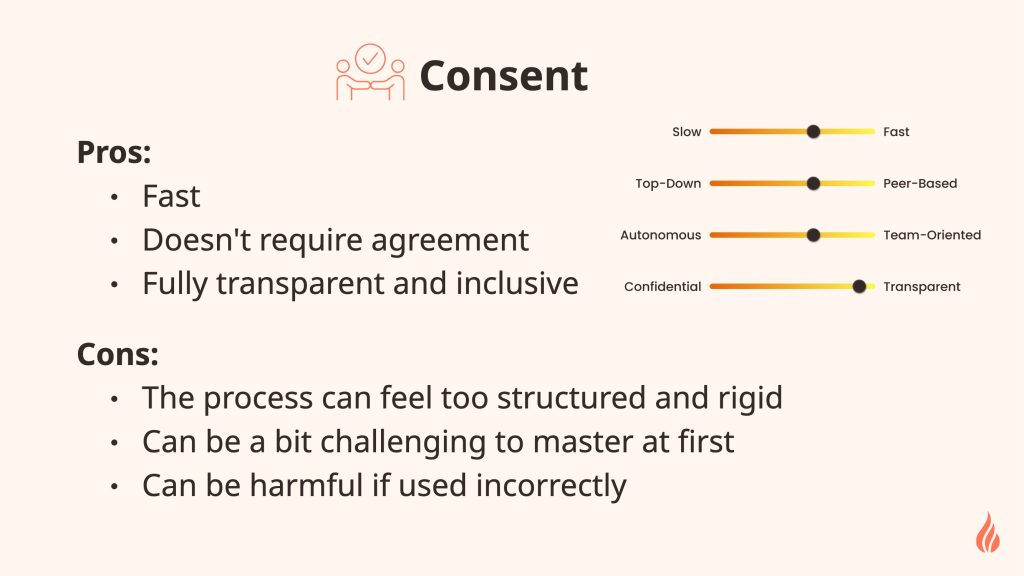
2. Advice Process
As our co-owner handbook states, “The advice process is a tool that helps decision-making via collective intelligence.” This elegant method balances individual ownership with collective wisdom.
In the Advice Process, a decision-maker consults those who will be affected by the decision and those with relevant expertise before making the final call. The key distinction: they must genuinely seek and consider advice, but they retain the authority to decide.
This approach shines for decisions owned by initiative drivers that affect others. When one of our developers needed to choose a new framework for a client project, they used the advice process to gather input from five team members while maintaining clear ownership of the final call. The result combined technical expertise, client knowledge, and implementation considerations without diffusing responsibility.
Note: The Masterclass includes our complete Advice Process templates, pitfall avoidance strategies, and facilitation techniques
3. Democratic Voting
While voting often gets a bad reputation for creating “winners and losers,” we’ve found it has its place in a balanced decision ecosystem. Democratic methods work well for clear-cut choices between well-defined options when the stakes are moderate and time is limited.
Recently, we needed to choose between three office locations. After thorough discussion of the pros and cons, a simple vote was the most straightforward way forward. The key was ensuring everyone understood the options fully before voting, something many organizations miss when rushing to polls.
Note: Our Masterclass covers the specific criteria for when to use voting versus other methods
4. Consensus
We haven’t abandoned consensus entirely, we’ve just limited it to where it truly matters. For foundational decisions that require deep buy-in from everyone, taking the time to reach full agreement is worth the investment.
When establishing our profit-sharing model, we took the time for full consensus because the long-term implications demanded complete alignment. This wasn’t quick or easy, but the result has stood the test of time with remarkably high commitment precisely because everyone genuinely agreed with the approach.
Note: The Masterclass includes our framework for determining which rare decisions warrant full consensus
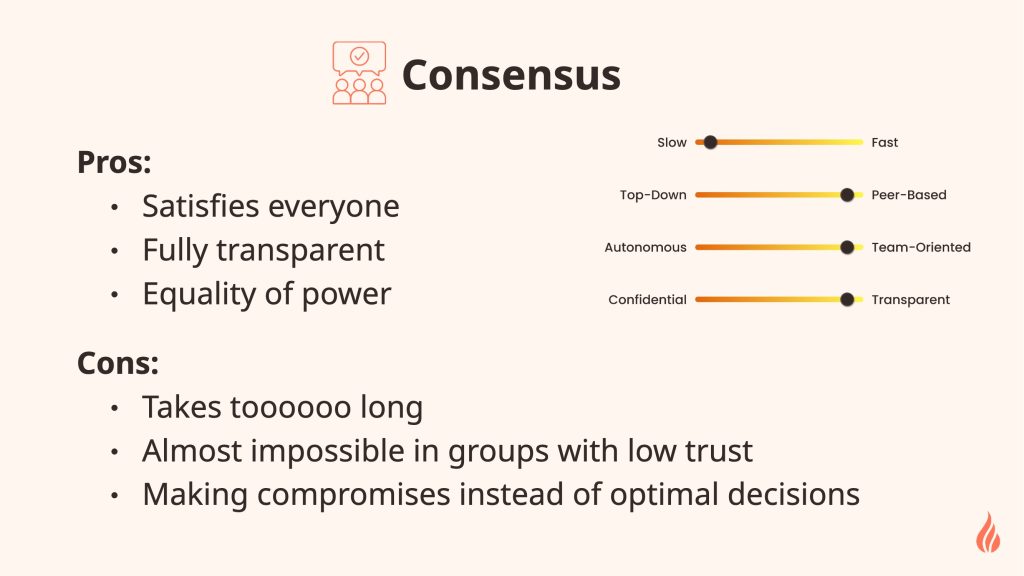
5. Autocratic (with transparency)
Perhaps most surprisingly, we’ve found that even in a cooperative, there’s a place for what might be called “autocratic” decisions, though we’ve reframed them to be transparent and appropriate to specific contexts.
In emergencies, situations requiring specialized expertise, or for low-impact operational choices, having a single decision-maker is often most effective. During a recent server outage, our ops lead made rapid decisions without consultation, and that was exactly what the situation required. The key difference? This authority was explicitly granted for this context, not assumed as a default.
Note: Our Masterclass provides the complete decision criteria framework for determining when autocratic decisions are appropriate
Decision-Making Mindsets Matter
We’ve learned that effective decision-making depends as much on mindset as on process. The best methods fail when approached with the wrong attitudes.
We cultivate a co-creative approach where people genuinely listen to understand needs rather than defend positions. When giving advice, we focus on offering perspective while respecting the decision-maker’s autonomy. And we encourage specific, thoughtful input rather than vague feedback.
These mindsets create the psychological foundation that allows our decision processes to function effectively. Without them, even the most carefully designed methods can devolve into politics or performative participation.
Note: The Masterclass includes specific exercises and techniques for developing these essential mindsets across your team
Digital Tools That Support Our Decision-Making
Loomio: Asynchronous Decision Support
For a distributed team like ours, having digital tools that support different decision methods is essential. We use Loomio for many of our asynchronous decisions, particularly those that benefit from reflection time and don’t require real-time discussion.
Our case study in Loomio’s blog details how this platform has helped us scale our decision-making as we’ve grown, particularly for decisions that don’t require everyone to be in the same virtual room at the same time.
Team Decision Making Masterclass by Camplight
This hands-on masterclass gives your team everything you need to make better decisions together. You will learn all five methods: Consent, Advice, Voting, Consensus and Autocratic.
It includes:
- Clear guidance on when to choose each method and how to set it up
- Step by step instructions for running each decision session
- Customizable templates to build your own Decision Map and meeting agendas
- Real world examples from Camplight’s own experiences
- Short exercises to practice facilitation and overcome objections
Use this toolkit with Loomio’s asynchronous features. You can blend online decision support with in person practices so your team moves faster, stays inclusive and learns by doing.
The Real Impact: Results That Matter
Measurable Improvements
The proof of any decision framework is in the results it delivers. Since implementing our structured approach, we’ve seen:
- Initiative completion rate was improved.
- Average meeting time for decisions decreased.
- Decision implementation success rate increased.
The real-world impact on our business has been undeniable. Our improved decision-making framework has contributed to transformative changes across Camplight:
- A 40% increase in revenue as we’ve made clearer strategic choices
- Refined positioning that focuses on a specific client niche where we make the most impact
- Successfully integrating more members and co-owners with clear and transparent processes
- A more defined offer for non-technical businesses on how to build new digital business lines or accelerate existing ones
- Co-created a startup (Team-GPT) that got the highest seed round in Bulgaria of 4.5 million euros
- The ability to co-create other decentralized networks like Bulgarian Digital Alliance, Patio Network, Techlight and more
These business outcomes represent the real human impact of having a framework that lets us make better decisions together without the friction and fatigue of our previous approaches.
Cultural Transformation
Beyond the numbers, we’ve experienced a profound cultural transformation. Team members report higher psychological safety, knowing that there’s a structured way to raise concerns that will be heard and integrated. The clarity about which decisions use which methods has eliminated much of the anxiety and confusion that previously surrounded decision points.
As one team member put it: “Before our decision framework, I never knew when I should speak up or how my input would be received. Now I understand exactly how and when my voice matters, which makes me more confident in contributing where it counts.”
Our decision methods are manifestations of our core belief that people can be trusted to act in the organization’s best interest. This trust foundation has transformed our culture and performance in ways that extend far beyond individual decisions.
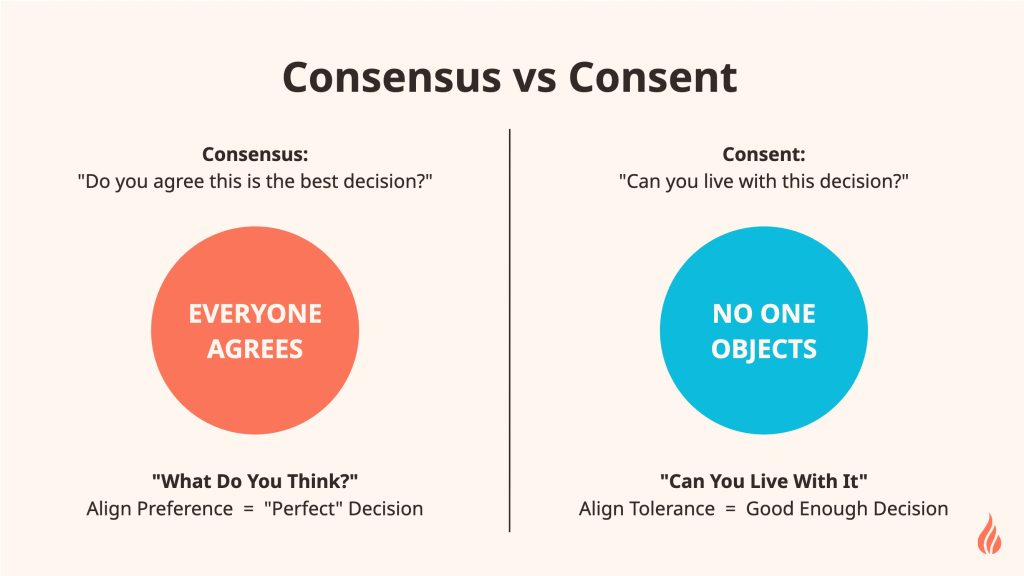
Client Benefits
Perhaps most significantly, our improved decision-making directly affects client outcomes. Clients notice the clarity and confidence with which we navigate complex choices, and many have commented on how our structured approach leads to better results.
As one client recently shared: “What impressed me most about working with Camplight wasn’t just their technical expertise, but how they made decisions. They knew when to involve us, when to move quickly, and how to integrate different perspectives without getting stuck. It’s a level of decision maturity I rarely see in technical partners.”
How Organizations Can Start This Journey
Begin With Intention
If you’re inspired to improve decision-making in your organization, we recommend starting small with focused implementation. Choose one decision type that’s currently frustrating your team and apply a new method to it. As you build confidence and see results, you can expand to other decision types.
The mindset shift is perhaps the most crucial element for successful implementation. Teams need to move from seeing decisions as power struggles or necessary evils to viewing them as collaborative opportunities to harness collective intelligence. This means cultivating curiosity instead of defensiveness, genuine listening instead of waiting to speak, and a willingness to evolve one’s thinking based on new information.
As Marin often reminds new team members: “The quality of our decisions is directly proportional to the quality of our conversations. And the quality of our conversations depends on how we show up mentally and emotionally, not just the process we follow.”
Note: The Masterclass provides a complete implementation roadmap with milestone tracking tools
Before you jump in, it helps to know what to watch out for and what can transform your process.
Early Pitfalls
- Fake consensus trap
You think everyone agrees only to find later that some people just nodded along. That can lead to decisions that never truly stick. - Process overload phase
Adding too much structure to every choice creates unnecessary friction. Simple decisions get bogged down in meetings and checklists. - Method mixing confusion
Without a clear map, people aren’t sure whether you’re asking for advice or seeking consent. That mismatch of expectations causes frustration and delays.
Key Breakthroughs
- Matching methods to decisions
We learned that different situations call for different approaches. Building a Decision Map gave everyone clarity on which method to use when. - Facilitation matters
Even the best processes fail without good facilitation. Learning how to guide a session smoothly is as important as choosing the right method.
Conclusion
Our team decision-making approach has become a competitive advantage, both in how we operate internally and in the value we deliver to clients. It allows us to combine the best aspects of cooperative ownership with the speed and clarity that modern business demands.
This journey continues to evolve as we learn and refine our methods. What remains constant is our commitment to matching the right decision approach to each situation, creating clarity about appropriate involvement, and maintaining the trust foundation that makes meaningful collaboration possible.
Additional Resources
For those interested in learning more about these decision-making approaches, we’ve made the introductory chapter of our Decision Making Masterclass available as a free resource. It covers the basic frameworks and includes a simple exercise to help you start mapping decision types in your own organization.


